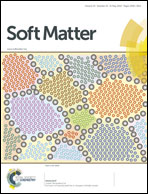Stimuli-responsive supramolecular micellar assemblies of cetylpyridinium chloride with cucurbit[5/7]urils†
Abstract
This article demonstrates, for the first time, construction of novel cucurbituril (CB)-adorned supramolecular micellar assemblies of a cationic surfactant, cetylpyridinium chloride (CPC), through noncovalent host–guest interactions. The distinct cation receptor features and cavity dimensions of the CB5 and CB7 homologues assert that the macrocyclic hosts remain complexed with the CPC monomers and take part in the micelle formation, a unique observation in contrast to that of the classical host, β-cyclodextrin. The cooperative contributions of the CB macrocycles in the micelle formation have been documented by the photochemical, surface tension, conductivity, DOSY NMR, and SANS measurements. The contrasting downward and upward shifts in the cmc of the CPC surfactant, respectively, with CB5 and CB7 hosts provide a unique opportunity for the controlled tuning of the micellization region for CPC from 0.57 to 1.6 mM, by using a combination of the macrocyclic hosts. The article also establishes the reversible response of these soft supramolecular micellar structures to thermal-stimuli, which projects their utility for on-demand smart drug-delivery vehicles.
![Graphical abstract: Stimuli-responsive supramolecular micellar assemblies of cetylpyridinium chloride with cucurbit[5/7]urils](/en/Image/Get?imageInfo.ImageType=GA&imageInfo.ImageIdentifier.ManuscriptID=C3SM52024B&imageInfo.ImageIdentifier.Year=2014)

 Please wait while we load your content...
Please wait while we load your content...